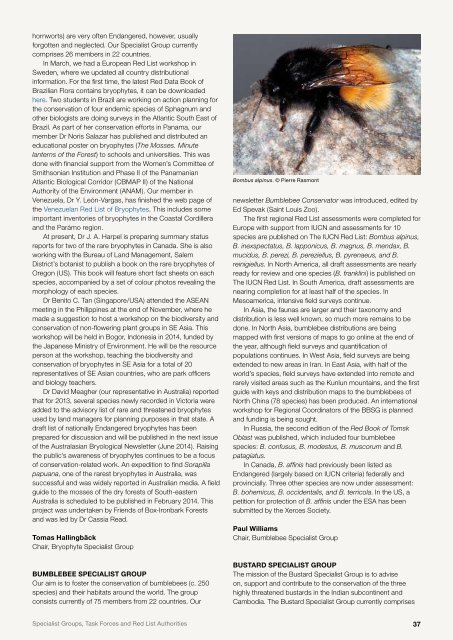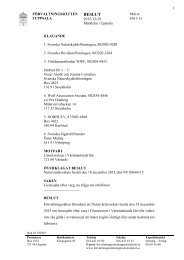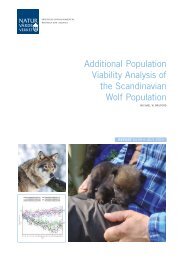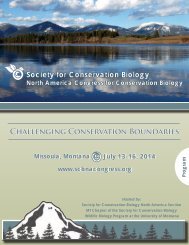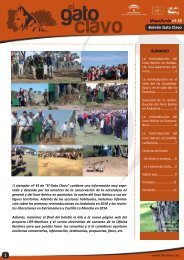1oC3Dbk
1oC3Dbk
1oC3Dbk
You also want an ePaper? Increase the reach of your titles
YUMPU automatically turns print PDFs into web optimized ePapers that Google loves.
hornworts) are very often Endangered, however, usually<br />
forgotten and neglected. Our Specialist Group currently<br />
comprises 26 members in 22 countries.<br />
In March, we had a European Red List workshop in<br />
Sweden, where we updated all country distributional<br />
information. For the first time, the latest Red Data Book of<br />
Brazilian Flora contains bryophytes, it can be downloaded<br />
here. Two students in Brazil are working on action planning for<br />
the conservation of four endemic species of Sphagnum and<br />
other biologists are doing surveys in the Atlantic South East of<br />
Brazil. As part of her conservation efforts in Panama, our<br />
member Dr Noris Salazar has published and distributed an<br />
educational poster on bryophytes (The Mosses. Minute<br />
lanterns of the Forest) to schools and universities. This was<br />
done with financial support from the Women’s Committee of<br />
Smithsonian Institution and Phase II of the Panamanian<br />
Atlantic Biological Corridor (CBMAP II) of the National<br />
Authority of the Environment (ANAM). Our member in<br />
Venezuela, Dr Y. León-Vargas, has finished the web page of<br />
the Venezuelan Red List of Bryophytes. This includes some<br />
important inventories of bryophytes in the Coastal Cordillera<br />
and the Parámo region.<br />
At present, Dr J. A. Harpel is preparing summary status<br />
reports for two of the rare bryophytes in Canada. She is also<br />
working with the Bureau of Land Management, Salem<br />
District’s botanist to publish a book on the rare bryophytes of<br />
Oregon (US). This book will feature short fact sheets on each<br />
species, accompanied by a set of colour photos revealing the<br />
morphology of each species.<br />
Dr Benito C. Tan (Singapore/USA) attended the ASEAN<br />
meeting in the Philippines at the end of November, where he<br />
made a suggestion to host a workshop on the biodiversity and<br />
conservation of non-flowering plant groups in SE Asia. This<br />
workshop will be held in Bogor, Indonesia in 2014, funded by<br />
the Japanese Ministry of Environment. He will be the resource<br />
person at the workshop, teaching the biodiversity and<br />
conservation of bryophytes in SE Asia for a total of 20<br />
representatives of SE Asian countries, who are park officers<br />
and biology teachers.<br />
Dr David Meagher (our representative in Australia) reported<br />
that for 2013, several species newly recorded in Victoria were<br />
added to the advisory list of rare and threatened bryophytes<br />
used by land managers for planning purposes in that state. A<br />
draft list of nationally Endangered bryophytes has been<br />
prepared for discussion and will be published in the next issue<br />
of the Australasian Bryological Newsletter (June 2014). Raising<br />
the public’s awareness of bryophytes continues to be a focus<br />
of conservation-related work. An expedition to find Sorapilla<br />
papuana, one of the rarest bryophytes in Australia, was<br />
successful and was widely reported in Australian media. A field<br />
guide to the mosses of the dry forests of South-eastern<br />
Australia is scheduled to be published in February 2014. This<br />
project was undertaken by Friends of Box-Ironbark Forests<br />
and was led by Dr Cassia Read.<br />
Tomas Hallingbäck<br />
Chair, Bryophyte Specialist Group<br />
Bumblebee Specialist Group<br />
Our aim is to foster the conservation of bumblebees (c. 250<br />
species) and their habitats around the world. The group<br />
consists currently of 75 members from 22 countries. Our<br />
Bombus alpinus. © Pierre Rasmont<br />
newsletter Bumblebee Conservator was introduced, edited by<br />
Ed Spevak (Saint Louis Zoo).<br />
The first regional Red List assessments were completed for<br />
Europe with support from IUCN and assessments for 10<br />
species are published on The IUCN Red List: Bombus alpinus,<br />
B. inexspectatus, B. lapponicus, B. magnus, B. mendax, B.<br />
mucidus, B. perezi, B. pereziellus, B. pyrenaeus, and B.<br />
reinigiellus. In North America, all draft assessments are nearly<br />
ready for review and one species (B. franklini) is published on<br />
The IUCN Red List. In South America, draft assessments are<br />
nearing completion for at least half of the species. In<br />
Mesoamerica, intensive field surveys continue.<br />
In Asia, the faunas are larger and their taxonomy and<br />
distribution is less well known, so much more remains to be<br />
done. In North Asia, bumblebee distributions are being<br />
mapped with first versions of maps to go online at the end of<br />
the year, although field surveys and quantification of<br />
populations continues. In West Asia, field surveys are being<br />
extended to new areas in Iran. In East Asia, with half of the<br />
world’s species, field surveys have extended into remote and<br />
rarely visited areas such as the Kunlun mountains, and the first<br />
guide with keys and distribution maps to the bumblebees of<br />
North China (78 species) has been produced. An international<br />
workshop for Regional Coordinators of the BBSG is planned<br />
and funding is being sought.<br />
In Russia, the second edition of the Red Book of Tomsk<br />
Oblast was published, which included four bumblebee<br />
species: B. confusus, B. modestus, B. muscorum and B.<br />
patagiatus.<br />
In Canada, B. affinis had previously been listed as<br />
Endangered (largely based on IUCN criteria) federally and<br />
provincially. Three other species are now under assessment:<br />
B. bohemicus, B. occidentalis, and B. terricola. In the US, a<br />
petition for protection of B. affinis under the ESA has been<br />
submitted by the Xerces Society.<br />
Paul Williams<br />
Chair, Bumblebee Specialist Group<br />
Bustard Specialist Group<br />
The mission of the Bustard Specialist Group is to advise<br />
on, support and contribute to the conservation of the three<br />
highly threatened bustards in the Indian subcontinent and<br />
Cambodia. The Bustard Specialist Group currently comprises<br />
Specialist Groups, Task Forces and Red List Authorities<br />
37


